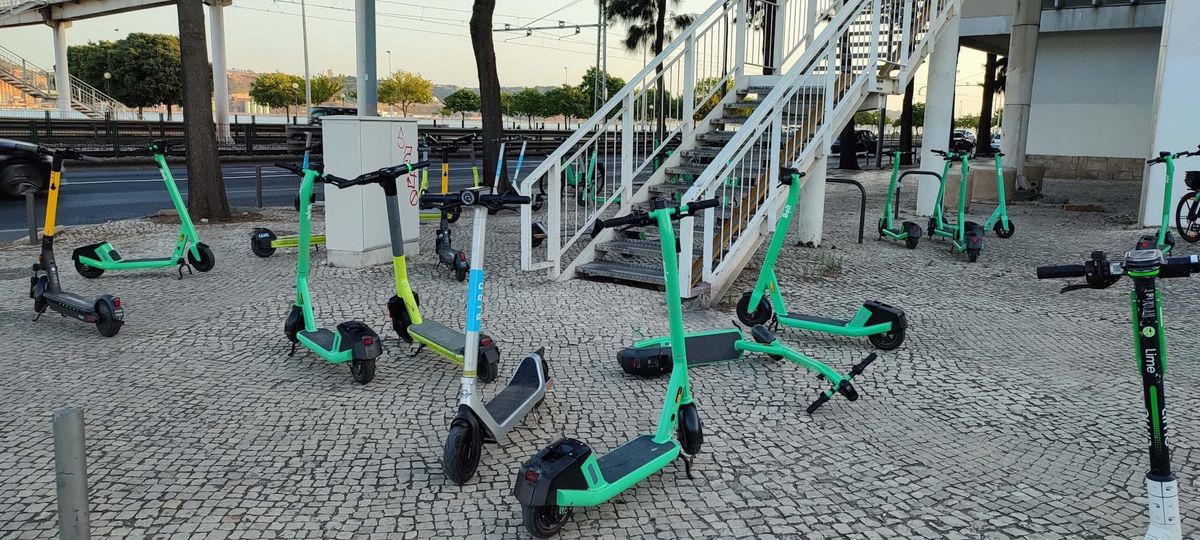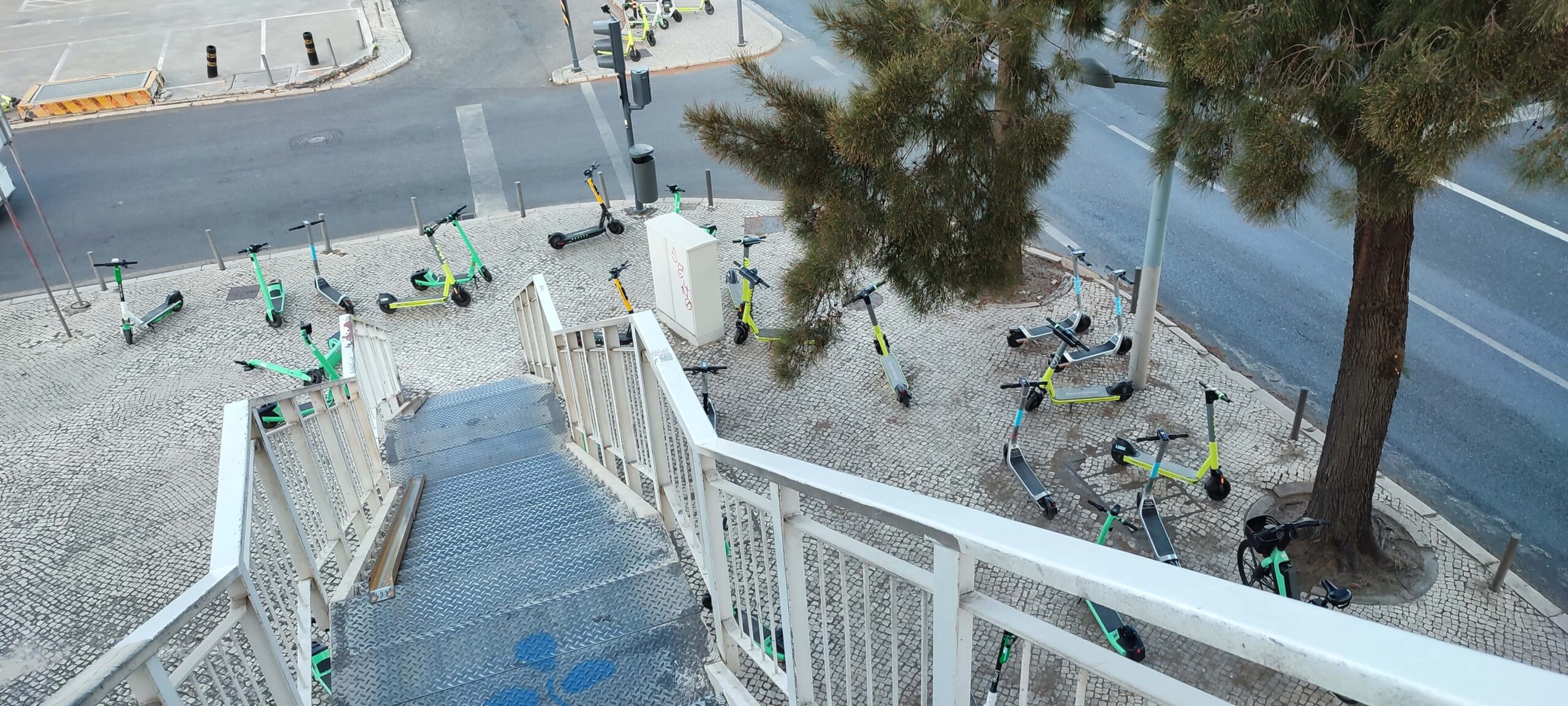Are electric scooters good for the (urban) environment?

Yesterday when I came back from the gym, I had to get off my bike and remove some of these e-scooters you see in the picture. They were literally blocking the way (and taking the bike up and down the bridge is difficult enough as it is). That made me think about the proliferation of these electric means of transport, and weather they are good for the environment as a whole and, more specifically, for the urban environment.
The Problem With Electric Scooters
As I have been traveling through different countries for the past 7 years, I have a pretty good overview of how electric scooters have transformed cities. I still remember the first time I saw one. It was in Estonia (obviously :), from Bolt, and I rushed to create an account to give it a try.
At the beginning, I applauded the startups behind them. E-scooters, I thought, would not only reduce our dependance on fossil fuels and decrease air pollution, but would also transform the landscape (once massive adoption was reached) to a more human-first, people-centered setup. Finally, we would build and design our cities for their people, not their cars.
However, time has proven me wrong. The issue here, as we will see, is not the tecnology, but the business model. To illustrate my point, it’s neccesary to consider how these scooters work and who is using them.
The Wrong Business Model
These scooters were supposed to become an alternative for urban mobility, designed to replace one’s car. People would eventually abandon more polluting means of transport and start using these (supposedly) eco-friendly devices.
The reality is that not a lot of people is doing that. The costs of using the services of Bolt, Lime, Bird or Link on a daily basis, to go to work and move through the city, are quite high. The price of riding a Bolt from Alcantara to the city center of Lisbon can easily be 4-5x the price of a bus or tram ticket. The trip takes more or less the same time, and you are exposed to the traffic in some areas (without bike lanes). The main issue here, though, is that they are expensive, and there is no monthly pass or similar initiative to attract regular customers.
Also, the urban landscape can sometimes make it difficult to use them. Lisbon, with bridges between the riverfront and inner areas, and steep hills going up and down cobbled stone streets, makes it really uncomfortable to use them on a regular basis.
This means that, in practice, e-scooters are used mainly by turists. People who will drive them for a short time, once or twice at most, before going back home. This poses two problems:
- First, they are not careful with the devices, which means a short lifespan for them. This has an impact on its sustainability as we will see.
- Second, they leave them anywhere when they finish their ride, which at scale affects the urban landscape.

e-Scooters Are Cluttering The Urban Landscape
As people using these scooters are mostly tourists on a short trip to the city, they are not specially concerned about where they leave them when they finish their ride. They don’t use the city infrastructures much (bike lanes, bridges, roads, sidewalks), so it’s totally ok to abandon them anywhere.
However, that becomes a nuissance for the people who live in the city. I was about to crash with a girl riding a bike the other day when she invaded my lane. It was not totally her fault, she was trying to avoid a scotter parked in the middle of the way, just in the curve (with limited visibility).
While this may not be the fault of the guys behind these startups, it is the direct result of their business models, and I am sure there has to be smart ways of fixing this, like using AI to check the photo users have to take when they finish their ride to identify when the vehicle has been left in a bad place and ask the user to move it. Another idea is leaving them only in designated points. It will probably be more costly, but it would greatly improve the relationship between these devices and the inhabitants of the city.
These companies may not feel the pressure of taking measures right now, but we know how governments work… When a new technology starts causing issues like these their reaction is banning that technology. This has happened already in many European cities.
e-Scooters Are Hijacking Our Spaces
The problem is not just that e-Scooters are carelessly abandoned by the users anywhere. The companies behind these devices are hijacking the public urban spaces for their own benefit.
The co-working space we are staying at has a very nice parking for bicycles at the entrance. The other day, when I arrived there, I was not able to park my bike. The whole parking was completely invaded by e-Scooters, parked in line one after the other in front of the parking spots.
e-Scooters don’t need to use these spots, but I cannot simply left my bike anywhere unless I want it to be stolen. These are public places for people to leave their bikes. These e-Scooters were not there by accident. These companies are using these (and many others) spots in the city as if they owned them.
This is one of the most infuriating things about e-Scooters for me. They are taking ownership of public spaces, bike lanes, bike parkings, sidewalks, roads, parks, and gardens.
They’re Not So Sustainable And Eco-Friendly After All
I was near the MAAT museum the other day when I saw a couple dragging an electric scooter down the marble stairs at the right of the impressive building. On every step, the scooter would hit the marble, causing cracks on the marble and damage on the metal surface of the scooter. The girl was doing that just to avoid using the ramp on the left side of the building, because that would probably take her 10-15 more seconds to go around the building and head right.
Apart from being vandalism, this is the result of a carelessness due to the fact that the scooter was not hers. This is happening everywhere, and it’s becoming a real problem affecting many important cultural landmarks around the world.
A recent study concluded that e-scooters are indeed not eco-friendly. This may seem counterintuitive, but let me explain why. When you measure the environmental impact of a vehicle, you must take into account all the energy consumed and CO2 (and similar) emissions generated during the whole lifecycle of the device.
In the case of electric scooters, that involves the manufacturing phase (most relevantly, including the battery, which is usually non-recyclable) and energy production stages, and then the driving/use stage, and the maintenance (charging) phase.
While it is true that no emissions are generated during the driving stage, the initial stages (and, most relevantly, the batteries included that are not recyclable) are quite polluting. During the maintenance phase, the scooters get collecte by a truck (that emits CO2) and recharged with energy that does not come from green sources.
Combined with the short lifespan of these devices, the result is that e-scooters emit 202 g of CO2 per km and passenger during their whole life cycle, roughly the same than a car.
It’s All About The Business Model
As you see, all these issues are caused by the business model of these startups. If you own one of these electric scooters, and take proper care of it, chances are, you are reducing your ecological footprint, CO2 emissions, and doing the right thing.
However, I’d like to see one of these providers (Bolt, Link, Lime, Bird, etc) offering a package that allows you to use the scooter for a long period of time (one month or more). That would help to solve the problem because it will encourage users to be more careful with these devices and more respectful with the urban landscape, thus extending their life cycle, which would compensate for the emissions in the initial stages of manufacturing and energy production.
A couple of other good suggestions include using electric vehicles to collect and distribute the scooters, and charging them with energy from renewable/green sources only.
The environment may or may not be a priority for the CEOs behind these startups (apart from greenwashing marketing campaigns), but they could really make a difference with just a few tweaks to the product and the business model. During the EU Startups Summit in Barcelona, I learned that none of these startups are profitable yet, so who knows, perhaps a monthly subscription option would allow them to break that barrier of “casual touristic usage” of their scooters and take them to the next level.




Comments ()